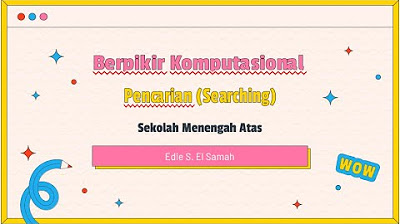Struktur Data dalam Informatika SMP/MTs Kelas 7
Summary
TLDRThe script discusses the concept of computational thinking in algorithms, using colorful activities to illustrate the process. It delves into optimization in scheduling and introduces the idea of data structures, explaining their organization and rules. Examples include alphabetical lists and non-alphabetical arrangements, highlighting the advantages and disadvantages of each. The script also presents an activity called 'Secret Word' to demonstrate sorting and arranging letters to form a message. Finally, it poses questions to test understanding of data structures, focusing on their arrangement, benefits, and drawbacks.
Takeaways
- 😀 The script discusses the concept of computational thinking, particularly the role of algorithms and activities like the 'colorful bracelet' activity.
- 🔍 It covers the section on optimization of scheduling with the activity of 'filling two activities', emphasizing how humans think computationally.
- 📚 The third part of computational thinking is introduced as 'data structures', which are organized arrangements that can follow certain rules or be freeform.
- 🛍️ An example of a data structure is given as a shopping list, which can be freely arranged or sorted according to specific rules like alphabetical order.
- 🔤 The script explains that in computer science, such arrangements are called 'lists' and can vary according to needs, such as sorting names alphabetically.
- 🔑 It outlines the advantages and disadvantages of alphabetically sorted data structures, like ease of search but ignoring the importance of information.
- 🗂️ Non-alphabetically sorted data structures are also discussed, with their pros and cons, such as clear priorities but difficulty in searching.
- 🔑 The script provides an activity called 'secret word' to illustrate the concept of data structures, where participants must arrange letters according to given rules to find a secret word.
- 📝 A series of questions are presented at the end of the script to test understanding of data structures, their organization, and the advantages and disadvantages of different sorting methods.
- 📉 The script highlights the importance of considering the context and purpose when choosing how to organize data structures, whether it be alphabetically or by other criteria.
Q & A
What is the concept of computational thinking as discussed in the previous meeting?
-The concept of computational thinking involves learning to think like a computer scientist, which includes understanding algorithms, data structures, and the automation of tasks through programming.
What is the significance of the 'colorful bracelet activity' in learning computational thinking?
-The colorful bracelet activity likely serves as a hands-on exercise to introduce students to the basics of algorithms and the step-by-step process of computational thinking.
What is the role of the 'filling two jugs activity' in the context of optimization and scheduling?
-The 'filling two jugs activity' is likely an exercise to teach students about optimization techniques in scheduling, where they learn to find the most efficient way to allocate resources or time.
What is the definition of 'data structure' as mentioned in the script?
-A data structure is a particular way of organizing data in a computer so that it can be used efficiently. It is a collection of data elements, where each element can be accessed according to a specific rule.
Why is the example of a shopping list relevant to understanding data structures?
-The shopping list example illustrates how data can be organized in a structured way, such as a list, which is a simple data structure. It helps in understanding the concept of ordering and accessing data.
What is the difference between a free-form structure and an alphabetically ordered structure?
-A free-form structure does not follow a specific order, while an alphabetically ordered structure arranges data, such as names or items, in order of the alphabet.
What are the advantages of an alphabetically ordered data structure?
-The advantages include ease of search and retrieval, as items can be quickly located by their initial letters, making it efficient for lookup tasks.
What are the disadvantages of an alphabetically ordered data structure?
-The disadvantages include the potential neglect of the importance or urgency of the information, as the order does not reflect the priority or relevance of the items.
What is the 'secret word activity' and how does it relate to data structures?
-The 'secret word activity' is an exercise where students are given cards with letters and must arrange them according to given instructions to reveal a secret word. It is a practical application of understanding and manipulating data structures.
How does the script use the concept of lists to explain data structures in informatics?
-The script uses the concept of lists, such as a list of student names or book titles, to demonstrate how data structures can vary based on needs and how they can be organized, such as alphabetically or by priority.
What is the significance of the exercise involving arranging letters on cards to find a secret word?
-This exercise is a practical way to teach students about the importance of order and structure in data organization, and how following specific rules can lead to the correct arrangement of data elements.
Outlines

This section is available to paid users only. Please upgrade to access this part.
Upgrade NowMindmap

This section is available to paid users only. Please upgrade to access this part.
Upgrade NowKeywords

This section is available to paid users only. Please upgrade to access this part.
Upgrade NowHighlights

This section is available to paid users only. Please upgrade to access this part.
Upgrade NowTranscripts

This section is available to paid users only. Please upgrade to access this part.
Upgrade NowBrowse More Related Video

Pencarian (Searching) - Informatika Kelas X

RANGKUMAN BAB 2 - INFORMATIKA KELAS 9 - STRUKTUR DATA MODEL GRAPH AND TREE

02. Berpikir Komputasional - Optimasi Algoritma - Informatika Kelas XI

Berpikir Komputasional dan Algoritma Pemrograman - Berpikir Komputasional - Informatika Kelas XII

Strategi Algoritmik dan Pemrograman (Proses Pemrograman) - Informatika Kelas XI

Yuk, Berpetualang di Dunia Algoritma SMP Kelas 9! | Materi Informatika Elemen Berpikir Komputasional
5.0 / 5 (0 votes)